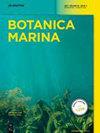Germanium dioxide as agent to control the biofouling diatom Fragilariopsis oceanica for the cultivation of Ulva fenestrata (Chlorophyta)
IF 1.4
4区 生物学
Q2 MARINE & FRESHWATER BIOLOGY
引用次数: 0
Abstract
During the cultivation of将二氧化锗作为生物污损硅藻Fragilariopsis oceanica的控制剂,用于养殖莼菜(叶绿藻)。
在陆基水产养殖系统中培育毛莼菜的过程中,生物污点硅藻大洋藻(Fragilariopsis oceanica)会在水槽表面定殖,最终影响大型藻类的生物量。由于二氧化锗(GeO2)是一种有效的硅藻生长抑制剂,本研究旨在了解二氧化锗如何影响海洋藻的存在以及作为生物量生产主要参数的 U. fenestrata 的光合作用和生长。毒性剂量反应实验表明,在 0.014 毫克/升的低 GeO2 浓度下,硅藻的生长受到抑制。相反,分别在 1 升玻璃烧杯和 100 升有机玻璃水槽中进行的小型和大型实验表明,在较宽的 GeO2 浓度范围(0.022-2.235 毫克/升)下,U. fenestrata 的光合作用性能和生长率不受影响。在后者中,水槽中的硅藻密度降低了 40%。在生长率分别为 20% 和 11.5% d-1 的生长条件下,使用 GeO2 所产生的成本介于 2.35 欧元和 8.35 欧元 kg-1 鲜重的 U. fenestrata 生物量之间。在 U. fenestrata 的陆基生物量生产过程中,GeO2 是一种有效的生物污损硅藻控制剂,如海洋藻。
本文章由计算机程序翻译,如有差异,请以英文原文为准。
求助全文
约1分钟内获得全文
求助全文
来源期刊

Botanica Marina
生物-海洋与淡水生物学
CiteScore
4.10
自引率
4.50%
发文量
43
期刊介绍:
Botanica Marina publishes high-quality contributions from all of the disciplines of marine botany at all levels of biological organisation from subcellular to ecosystem: chemistry and applications, genomics, physiology and ecology, phylogeny and biogeography. Research involving global or interdisciplinary interest is especially welcome. Applied science papers are appreciated, particularly when they illustrate the application of emerging conceptual issues or promote developing technologies. The journal invites state-of-the art reviews dealing with recent developments in marine botany.
 求助内容:
求助内容: 应助结果提醒方式:
应助结果提醒方式:


